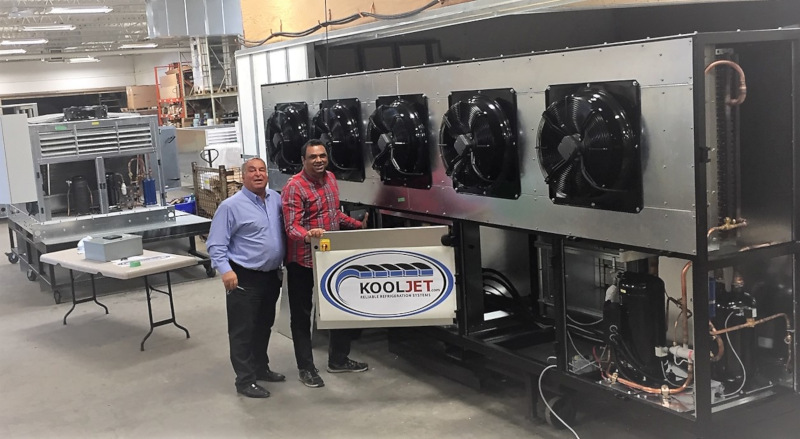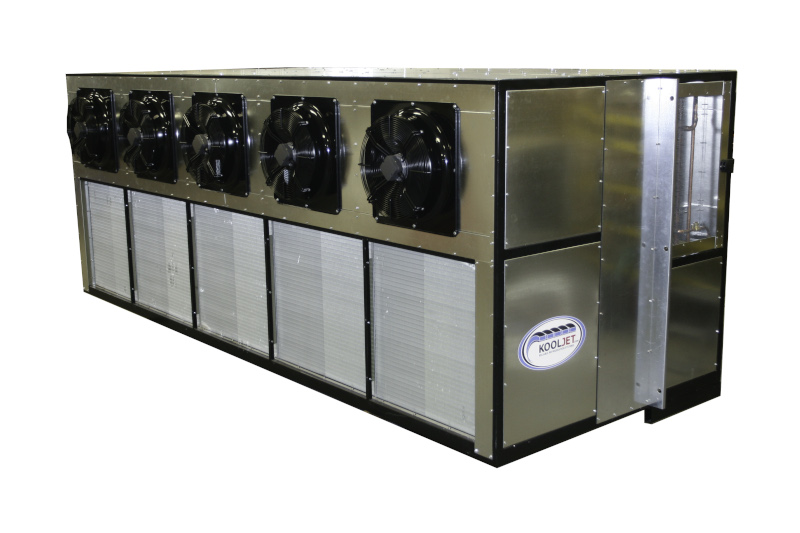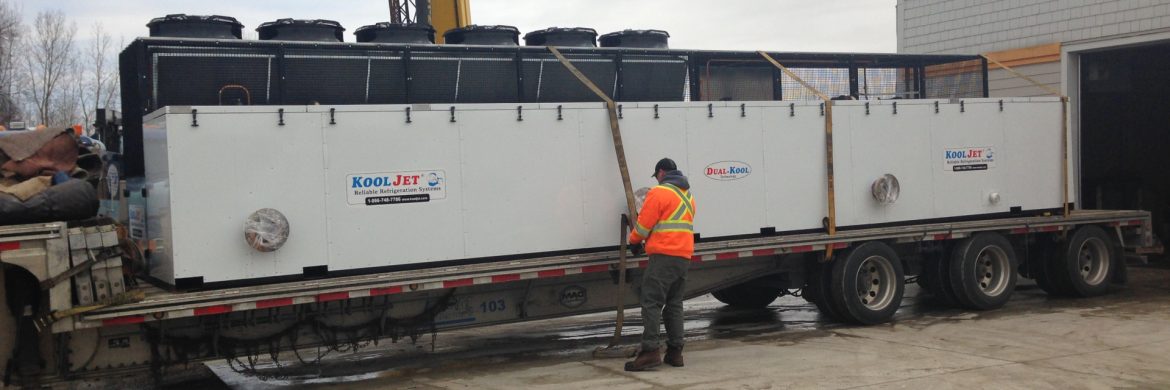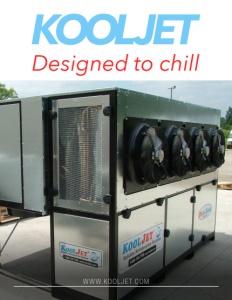KoolJet
Designed to chill
Business View Magazine interviews KoolJet President & CEO, Pat Occhicone, and Vice President, JD Wasir, for our focus on Cold Storage in Canadian Fisheries.
Designing and building custom equipment that performs in environments from plus 55 degrees F. down to minus 76 F. is no simple feat. But for the innovative team at KoolJet in Brantford, Ontario, it’s all in a day’s work. Seriously, they know how to chill. Since its inception in 2001, KoolJet has developed expertise and knowledge among farmers, fisheries, food processors, and beverage companies. Its effective and efficient refrigeration and air movement equipment is designed to properly cool, freeze, and preserve perishables for maximum weight, appearance, and nutrition.
Meat, shrimp, and fish products are often rapidly frozen using blast freezing rooms. KoolJet manufactures ultra-low setpoint, high capacity refrigeration packages, and low-temp, high velocity blast-freezing air handlers designed to rapidly freeze products before they are transferred to longer term holding areas, where demands on the refrigeration system and air movement devices are quite different.
Business View Magazine recently spoke with KoolJet Vice President, J.D. Wasir, and President/CEO, Pat Occhicone, about their thriving company and the very cool innovations they’re bringing to the commercial refrigeration sector. The following is an edited transcript of that conversation.

BVM: Can you give us some background on KoolJet?
Wasir: “We are in business 18 years. I started this company with another gentleman in 2001. He eventually retired and Pat became a major shareholder in 2016. Now, Pat and I are partners. Kooljet originally started in Tillsonburg, Ontario, moved down the road to Delhi for a few years, then back to Tillsonburg, and we just moved to Brantford in November 2018. For many years, we were doing a certain kind of work and now we have a much bigger building with new presses, all new CNC machinery and our process is slowly becoming more automated. We have some big contracts under our belts and we’re trying to bring the company to the next level. The building is 100,000 sq. ft. but we’re only using one third of the facility, and leasing out the other two thirds. So, when we need to expand the room will be there.
“We have 18 employees, including office staff. Most of them have been with us a long time, some from day one. When we moved, 70 to 80 percent of them came with us. The rest, we hired locally and we are still in the process of hiring more. We do design, engineering, and manufacturing of units. Nothing is off the shelf. We go to the customer to learn their needs and then we design a specific system for them.”
BVM: Is it true there’s a particularly chilling story about a tuna freezer?
Wasir: “Yes. We have customers in the fisheries sector that we’ve supplied freezers to in the past. The units are usually designed for minus 18 degrees F. but, in 2009, we custom-designed a freezer for tuna fish that the client, Japan Foods in Mississauga, wanted to maintain at minus 76 degrees. It’s been successfully running for ten years now. That’s the lowest temperature we’ve done so far. When you go in that room, even your eyes freeze, it’s so cold. We couldn’t make it as a freestanding building with those deep temperatures, so this room was made inside a cold room that had an ambient temperature of about minus 20 degrees. Then, we built the tuna room for minus 76. We had to use a split-type system; the condenser was mounted on the roof and the evaporator coils were in the room. There was a lot of technology, a lot of challenges involved. We couldn’t find the right fans or the right compressors. We had to import the fans from Germany and they said they would only go to minus 70, so we had to wrap that unit to keep it warm.”
BVM: What do your current operations entail?
Wasir: “We are strictly OEMs. We do not have an installation group. So, mostly, we make a package unit with everything on a common skid. Before we ship it out, we spend more than a day testing the equipment in a special room in the shop, where we maintain the desired temperature and humidity. We check everything, charge the unit with refrigerant, and once the end user gets it, all he has to do is cut an opening in an exterior wall, shove the unit into the space, and turn the toggle switch on. If there is a problem, maybe an accident in transit, then we’ll bring in local workers to check the unit and fix any damages.
“Our market is 60 to 70 percent in Canada. We also have lots of systems in Michigan; some freezer systems in Florida and other states, as well as overseas in Japan, China, and Singapore. Our packaged units are designed to fit on a trailer for road transport in Canada and the U.S., but if they go outside North America, we design them to fit in a sea-going container.”
Occhicone: “Our long-term goal is to have a rep network to cover the whole world, but in areas where we don’t have local representation, we deal directly with end users. When I say reps, it’s a rep organization – a sales agency – that caters to this industry. They basically fulfill for us – they might also sell other components to farmers or fisheries. If it’s for large freezer storage, or cooler storage, we may deal with a rep organization that would cater to the consulting engineers.
“The refrigeration demand is strong. KoolJet has enormous potential. We spent the first number of years developing the product, and JD has been instrumental in designing units to specific markets. He is a professional engineer, and the driving force in coming up with the bulk of the designs to deal with our customers’ needs. I’ve been in the industry over 30 years, and have business experience. I’m hoping to combine my strengths with JD’s technical abilities to grow the company and achieve more success because there is definitely a need for our products. Although we have some standard parameters that we try to design to, primarily there is some custom component or design involved.”

BVM: Besides the tuna freezer, what other unique products have you created?
Occhicone: “The other big feature that JD designed takes advantage of cool, fresher weather, especially in the northeastern, U.S. and parts of Canada. When the temperature drops below a specific setpoint outdoors, we are able to shut down the unit and achieve free cooling. The customer is then paying practically nothing for their cooling. That’s a huge benefit because they’re able to take advantage of the cold weather we’re blessed with and apply it to their process and their application. Anytime something is free, it catches people’s attention.”
Wasir: “We have some units in Nunavut, and this free cooling that Pat mentioned is perfect for them. Because, although, we get temperatures below minus 20 in Ontario, it’s not that often. In Nunavut, they go six months with temperatures of minus 30 degrees and below, and they’re still using this free cooling option. When they learn about our units and the free cooling, they realize it’s a big energy saver. We were able to do some math and show them how much energy and cost they can save by not running the compressor.”
Occhicone: “There is a lot of competition but not in the same approach that we take. Generally, people use conventional HVAC equipment for cooling and you can’t achieve free cooling, or the cost and energy savings we offer, with that equipment. We are the exclusive supplier of refrigeration to the LCBO (Liquor Control Board of Ontario). And we’re currently working with Costco – we supplied one of their facilities in Minnesota last year and we’re presently trying out another store in Houston, Texas. We’re very confident our units will meet all the requirements and perform to their expectations, and then we’re looking to have our refrigeration equipment in all their stores.”
BVM: How do you foresee the future of Kooljet?
Wasir: “There is vast potential in this industry. Global warming is kind of a mixed blessing for us. One of our challenges is what to pick and what not to pick. The opportunities are so vast. Every commodity, such as fish or produce, has its own season. So, it might be a lean time in winter, but come spring and summer everyone needs their freezer units at the same time. Then we work overtime, day and night, to produce those orders.”
Occhicone: “We moved to the new facility by design, by choice, and we’re looking in the next couple of years to grow and transform the company, while maintaining the core values and quality our customers have come to expect from us. Our future looks bright; we’re very excited about where we’re going. Growing a company is not without pain and challenges but we’re prepared to face those challenges and bring on the additional resources that are needed. We’re well positioned; KoolJet is a young company, but we have a core base and we’re looking forward to the opportunities that will bring us to a whole new level.”
AT A GLANCE
Who: KoolJet
What: Manufacturer of cooling systems for perishable foods
Where: Headquarters in Brantford, Ontario, Canada
Website: www.kooljet.com




